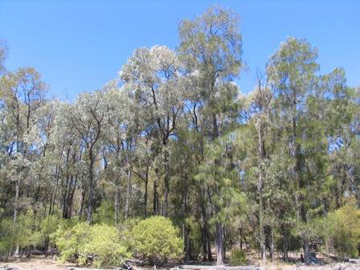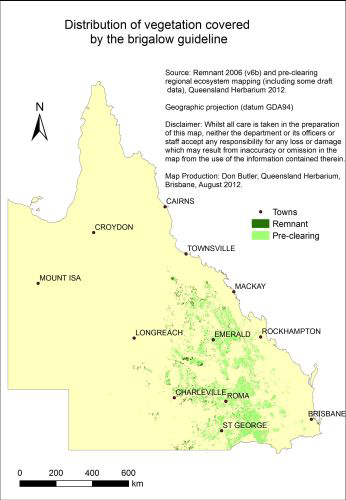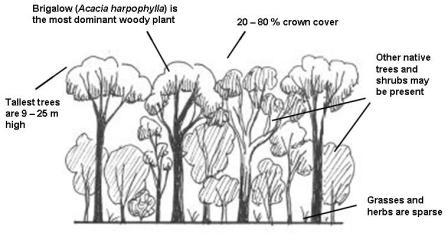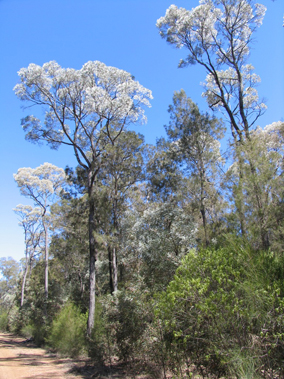Description

Mature brigalow with belah and wilga, north of Chinchilla.
What is it?
Brigalow is the name given to woodlands and open forests dominated by the brigalow tree (Acacia harpophylla). So ‘brigalow’ is both the name of a plant, and a vegetation type.
Where is it?
Brigalow occurs over a large area of eastern Australia, from south of Narrabri in New South Wales, to Charters Towers in north central Queensland.
Carbon potential
The above-ground parts of woody plants in brigalow woodlands can hold about 180 to 458 tonnes of carbon dioxide equivalent per hectare.
Regrowing brigalow will capture atmospheric carbon and store it in woody plant tissues. Conservative estimates of carbon accumulation rates in brigalow regrowth are between 3.3 and 5.5 tonnes of carbon dioxide equivalent per hectare per year. The rate of carbon accumulation is influenced by weather, and the age of the forest.
Read more about farming carbon and limits to carbon accumulation.

The distribution of pre-clearing and remnant brigalow vegetation in Queensland.
Restoration and management
Brigalow is hard to eradicate, which can help in restoring brigalow forests. This is because brigalow tends to grow a large number of shoots after it is disturbed. These shoots emerge from the roots and are known as suckers.
Rainfall and past clearing history have a large influence on carbon accumulation rates and standing carbon stocks in brigalow, but ongoing management, particularly of stem density, can also have a large effect.
Fires can affect brigalow restoration by preventing or slowing the establishment and growth of brigalow and other native plants, and by killing mature trees.
Cattle grazing can be compatible with reforestation in brigalow, as long as grazing pressure is held at low to moderate levels, and there is enough strategic spelling (periods where grazing is stopped) to allow new trees to establish.
In general, increasing the size and number of trees will reduce the carrying capacity for grazing.

Wildlife
Regrowing brigalow will benefit wildlife, especially animals such as birds, reptiles and land snails that depend on brigalow for habitat.
Features
Generally, mature brigalow vegetation in Queensland has the following features:
- Brigalow (Acacia harpophylla) are the tallest trees, and form the upper canopy layer. This canopy is between 9m and 25m tall.
- Canopy cover can vary from 20% to 80%.
- Other canopy trees may include belah (Casuarina cristata), red bauhinia (Lysiphyllum carronii) and the Queensland bottle tree (Brachychiton rupestris).
- Eucalypts, e.g. poplar box (Eucalyptus populnea), Dawson gum (E. cambageana)) and other wattles (e.g. gidgee (Acacia cambagei), may also be present in the tree layer.
- The shrub layer often includes wilga (Geijera parviflora), false sandalwood (Eremophila mitchellii) and yellowwood (Terminalia oblongata), but can also include many other species.
- The ground layer (including grasses) is generally sparse.
- There can be wide variation in the types and density of shrubs, small trees and canopy trees, which may relate to the local climate, soil type and how the site has been managed.

Brigalow with belah and a diverse shrub layer at Barakula in southern Queensland. View a larger image
Brigalow vegetation occurs in areas with average annual rainfall ranging from 500mm to 750mm, with rainfall highs in summer and winter (with most rain falling in summer), and a high variability in seasonal and annual rainfall.
Mature brigalow can develop into open forests (50–80% canopy cover) in high rainfall areas, and form woodlands (20–50% canopy cover) in drier areas. In wetter areas brigalow vegetation can start to merge with dry rainforest (semi-evergreen vine thicket or softwood scrub) with Acacia harpophylla present as an emergent tree.
Brigalow vegetation is often found on acidic and salty clay soils.


